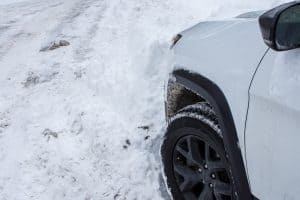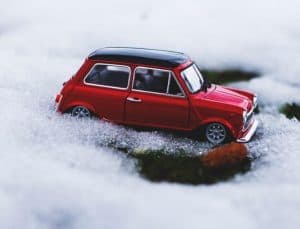The Winter season is associated with cold and snow that eventually coats the roads, melting and refreezing into ice. Driving on ice can expose you to dangerous driving experiences that you may end up stuck or engage in a fatal accident if not careful.
Now, what should you do when you hit an ice patch, and the vehicle starts to slide awkwardly? This article has some tips to guide you if you start sliding on ice while driving. Moving around on snowy roads is dangerous, especially if your car tires are worn out. Use this report to know what you should when you get yourself into such a situation.
Tips for driving on ice safely
Due to the available never-ending flurries and black ice, winter is the mother of sliding and slipping. Even experienced drivers understand that driving on snowy roads is sometimes inevitable. Below are some of the quick remedies to safely drive on ice:
1. Avoid abrupt braking
It’s our habit to apply brakes immediately when we sense danger, like a loss of control. Or you are overspeeding, and all of a sudden, an animal or a person crosses your way; you will immediately step on the brakes. However, this turns to be a little bit dangerous when it comes to driving on icy roads.
Instantly stopping your vehicle will land you in trouble; applying the brakes to stop the vehicle will worsen the situation. Therefore once you realize that you’re driving at a higher speed and the car starts to slide, braking shouldn’t be the first action. To counteract a slide, you need to ensure the vehicle’s wheels move freely.
2. Turn the front tires into the slide
On normal roads, we usually turn against the slide, but when it comes to icy roads, it’s vice versa. Experts recommend turning into the slide to counteract the situation; that’s the only way of fighting back the condition; for example, in occasions where the vehicle’s nose is on the right side of the road and the tail on the ice, turn the nose left.
Doing so is important because you will be straightening out the vehicle. This is what experts call ‘turning into the ice.’ Once you realize that your vehicle is straightened, you can now go on and straighten the wheel. Steer appropriately based on the slide angle your car is in the ice.
Try to use proportionate steering based on how severe the slide is. You don’t have to jump on the steering wheel without knowing where you should head. Maneuver the steering gently and return the car to an opposite direction for ultimate stability. Here, you should expect rocking forth and back motion; you need to respond carefully.
3. Avoid over steering
Oversteering is another action that you need to avoid when your car starts sliding on ice while driving. Turning the wheel should be done slowly and smoothly; abrupt steering will land you into the messier slide. Oversteering implies hard and sharp wheel reaction; your vehicle will be in a total spin.
Oversteering happens when the car rear tires begin skidding before the front wheels, making the car tail swing into the slide. You will be off-road, but you don’t have to strain. Give yourself hard and sharp steering spins. Doing so will overcorrect the situation, sending your vehicle to a tailspin.
4. Stay calm
Your car is sliding; you are scared and don’t know what to do? The safest remedy to such scenarios is to stay calm; don’t tense. You are in a critical condition, and you need to get yourself out of it; you can’t do anything if you’re unsettled. Getting some little skills and tips on what to do when your vehicle starts to slide on ice while driving is the wisest decision.
You can save lives once you know what to do when in a scary situation. Learning what and how to turn into the slide is the best trick when driving on snowy and icy roads. You don’t want to race against the ice patch. Face it once and for all to continue with the journey.
Before getting yourself into icy roads, experts recommend that you do many prior practices on-ice parking. You will know exactly what to do whenever you get yourself into such a situation. So, the rule is to stay calm, don’t panic.
Panicking will lead to oversteering and can worsen your slide, spin, and even causing an accident.
5. Reduce your speed
The next step to do to prevent your vehicle from sliding is to reduce the speed. You need to slow the vehicle when driving on icy and snowy roads. Federal Motor Carrier Safety Administration recommends reducing your car speed by ½ on snow roads and 1/3 on muddy/wet roads.
Reduce your vehicle’s speed to 40 mph on icy roads. However, speed reduction should be in a smooth transition; don’t overstep on the brakes. This could lead to a messier slide. On the other hand, you need to reduce your speed to 30 mph when driving on snow-packed roads.
Slick and icy roads need slower speeds, and sometimes you may pull off if it’s difficult to drive safely. Your life is more important than the situation.
6. Prior Auto Check-up
Proper prior planning prevents poor performance. This art is useful in making you stay safe while driving on icy roads; since sliding on the ice while driving is inevitable, having your vehicle prepared and serviced in advance could be a preventative remedy. It’s possible to predict winter because it’s seasonal; early preparation, therefore, gives a great opportunity for safe rides.
You need to take your car into an automotive; the mechanic should check the tires, ensuring they are in good working condition. Worn-out tires will ruin your journey; tire treads should be better for an excellent driving experience. The mechanic should also check your brakes to make them more responsive when the need arises.
7. Front-wheel skid
If your car front tires start to slide, remove your foot from the fuel and give the vehicle some seconds to slow down. After a while, if you’re still not in control of the car, apply the brake lightly; one toe is enough here. Avoid skidding by slowing down the vehicle.
8. Rear-wheel skid
Sometimes the problems might be arising from your car tires; they are important components in the vehicle. So, if the back wheels get out of the track, you have to gently turn the steering wheel towards the sliding directions. It would help if you did so while removing your foot from the accelerator; don’t break.
What to do to prevent sliding on ice while driving
When winter approaches, you will see most drivers practicing out, preparing for the coming season. Early preparation involves actions like taking your vehicle in the garage to be serviced. Its braking system should also be checked and ensure they are responsive.
The mechanic has to check the tire treads and rotate the tire or replace them if they are completely worn out. The wheels should also be aligned, rendering the vehicle into a balanced posture.
Frequently asked questions:
- Do I need a ticket to slide on ice?
Following and working with the appropriate authority is always advisable. Sliding on ice while driving can land you in problems as you may be prosecuted in court for failure to control your vehicle. Therefore, you should learn to incorporate with the assigned department.
- How should I brake on icy and snowy roads?
What you need to do is to utilize your ABS brakes properly. The ABS brakes can be activated by pressing and holding down the brake pedal. Expect to experience some pulsating and a growing sound; this is normal. However, you should know that sometimes ABS brakes may fail on ice, so your wheels can lock up.
- How fast should I drive on icy roads?
It depends on how critical the situation is, but one rule stands. Reduce your speed while driving on icy roads. Slowing down is necessary so that you don’t get out of control of the vehicle. Speeding up makes it difficult to stop, and you can easily lose control. For your safety and those of your loved ones, your speed should not exceed 40 mph.
- Why is it difficult to find a car moving around on slippery ice?
While driving on icy roads, tires don’t have much friction, making it hard to turn in your desired direction. The ice will reduce friction, reducing the force required by the care to change its direction towards the curve.
Final words
If you are driving on an icy road and your car starts skidding, don’t panic. What you need to do is to turn the vehicle in the skid direction. For example, if your car’s tail is swinging to the right, it’s advisable to turn the vehicle’s nose to the right.
Doing so is important to fight back the situation; turning the steering to the opposite direction will worsen the situation. So, face the ice and straighten out the car to straight its wheels tool. Hopefully, the above article equips you with tips on how to survive on icy roads with your car.
In this video, I talk about 4 tips for driving on icy roads! I live in Canada, and if you live here, you have to get used to driving on slick icy roads! With that being said, I made this video to go over some tips for driving on roads that are icy! It is important to slow down and ensure that you are leaving a lot of extra following distance because slippery roads mean less effective braking power and turning grip!
